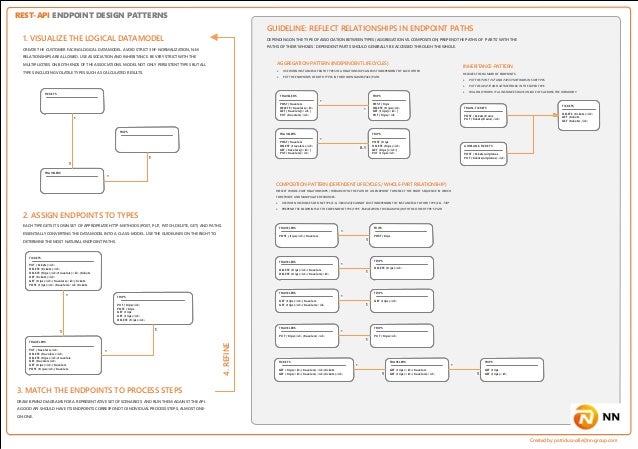Table Of Content
- REST API Design Best Practices Handbook – How to Build a REST API with JavaScript, Node.js, and Express.js
- In this article, we talk a bit about useful and intuitive design patterns in RestFul Webservice API architecture.
- Plan for Future Use Cases with API Parameters
- Managing Deprecated Endpoints
- Best practices for REST API design
- Resources and URI
- API Design Patterns: Best Practices for Building Resilient APIs

I think requesting to receive all workouts would effectively be served from our cache. You can store this type of data inside your cache and serve it from there instead of going to the database every time to query the data. Using a data cache is also a great practice to improve the overall experience and performance of our API. Imagine we've got 2,000 workouts, 450 records, and 500 members stored in our DB. When calling our endpoint to get all workouts we don't want to send all 2,000 workouts at once.
REST API Design Best Practices Handbook – How to Build a REST API with JavaScript, Node.js, and Express.js
Although there's the term JavaScript in JSON, it's not tied to it specifically. You can also write your API with Java or Python that can handle JSON as well. There are many different approaches to handling versioning inside an Express API. In our case I'd like to create a sub folder for each version inside our src directory called v1.
In this article, we talk a bit about useful and intuitive design patterns in RestFul Webservice API architecture.
The resource name in the response to this call must use the canonical nameof the resource, with actual parent collection identifiers instead of "-"for each parent collection. For example, the request above should return aresource with a name like shelves/shelf713/books/book8141, notshelves/-/books/book8141. An operation can provide information about its progress using theOperation.metadata field. An API should definea message for this metadata even if the initial implementation does notpopulate the metadata field.
Plan for Future Use Cases with API Parameters
In Restful APIs, multiple clients are connected to the same backend server. So when the internal representation of a server is changed, it should not affect API consumption at the client-side. In a loosely coupled design, APIs are independent, and modifications in one won't impact the operation of consumers. Within an API, the components get added, modified, or replaced.

Once the user's identity has been verified, the API can grant access to the requested resource. In this article, we will explore the benefits of using API design patterns, common patterns used in API development, and best practices for implementing API design patterns. Paths of endpoints should be consistent, we use nouns only since the HTTP methods indicate the action we want to take. Paths of nested resources should come after the path of the parent resource. They should tell us what we’re getting or manipulating without the need to read extra documentation to understand what it’s doing.
Pagination and filtering techniques are vital for API performance as they limit the data returned in a response, thereby reducing the server’s resource load. From cursor-based pagination to keyset pagination and Seek Paging, there are multiple techniques to allow efficient fetching of items in large datasets. Ideally, you can codify your organization’s approach once, rather than revisiting it each time you create an API. A style guide can keep your company on the same page with API design. In addition to being consistent between APIs, it’s even more important to maintain consistency within a single API. Often, when use cases are discovered after an API is built, engineers will create new endpoints to support these unearthed requirements.
API design is the process of making intentional decisions about how an API will expose data and functionality to its consumers. A successful API design describes the API's endpoints, methods, and resources in a standardized specification format. Note that if output only fields are set in the request or included ina google.protobuf.FieldMask, the server must accept the request withouterror. The server must ignore the presence of output only fields and anyindication of it.
PayPal's API Style Guide and Patterns - InfoQ.com
PayPal's API Style Guide and Patterns.
Posted: Fri, 22 Sep 2017 07:00:00 GMT [source]
API Design Patterns: Best Practices for Building Resilient APIs
In API design, discoverability and documentation are the unsung heroes. They play a crucial role in simplifying the use of API endpoints and ensuring that developers have the necessary guidance for quick implementation. HTTP specification comes up with a set of standard headers, through which the client can get information about a requested resource and carry the messages that indicate its representations. You may be designing microservices APIs, which have their own set of considerations. Everything covered in this post likely still applies, but you’ll want to pay extra careful attention when designing microservices. Each will need to make sense on its own, yet benefit from a combination (loose coupling).
REST API Best Practices
Whenever a client sends a request to an API, the API processes the request and returns a response. This process can sometimes take a considerable amount of time if the API has to perform complex database queries or execute resource-intensive operations. Caching helps to speed up this process by storing frequently accessed resources in a cache.
But as I said, in our example it's okay for me to only differentiate between the routes and let the router handle the rest. Nonetheless it's important to keep that in mind to have a clear structure when the API scales up and needs changes. The new directory /src/v1/routes will store all our routes for version 1. But for now let's add a simple index.js file to test things out. That's what we expose to the outside world and what can be consumed by other developers. But we also need to structure our project in order to differentiate between each version.
To improve the experience we also can send a quick error message along with the error response. But as I've written in the introduction this isn't always very wise and should be considered by the engineer themself. Now you can go to your HTTP client, send the POST request again, and you should receive the newly created workout as JSON. Let's go into our workout service and receive the data inside our createNewWorkout method.
Donations to freeCodeCamp go toward our education initiatives, and help pay for servers, services, and staff. We've defined all the properties that make up a workout including the type and an example. This should look very familiar if you've already worked with API's that have OpenAPI documentation. This is the view where all our endpoints will be listed and you can extend each one to get more information about it. This is basically the whole magic to add an endpoint to our swagger docs.
Learn how the API design process can help teams deliver adaptable, testable, and well-documented APIs to consumers. If there isa common default behavior, then it shall be used when an enum value is notexplicitly specified. If there is no common default behavior, then the 0value should be rejected with error INVALID_ARGUMENT when used.
Authentication is the process of verifying the identity of a user or system. In API design, authentication is used to ensure that only authorized users or systems can access the API. This is typically done by requiring users to provide some form of credentials, such as a username and password, an access token, or a digital certificate.
Returning all workouts is pretty simple and we don't have to do transformations because it's already a JSON file. It's also a good practice to name the service methods the same as the controller methods so that you have a connection between those. Let's create our service layer by implementing the next best practice. After setting it all up we can now dive into the real implementation of our API.

No comments:
Post a Comment